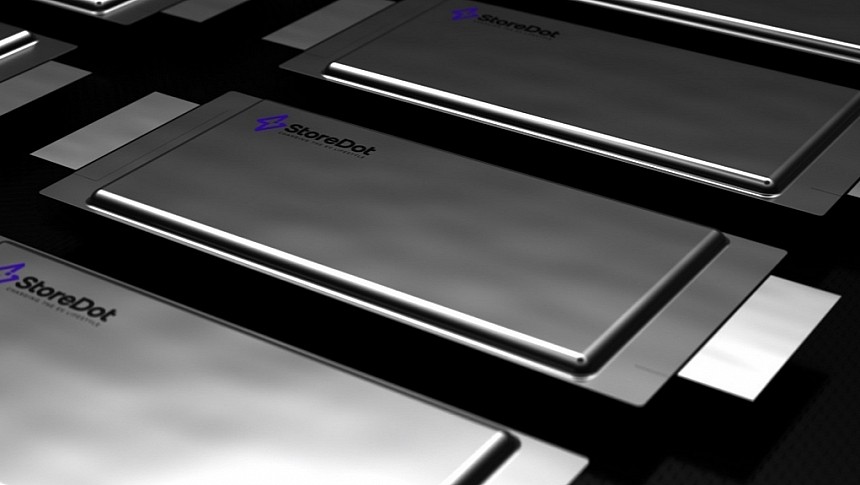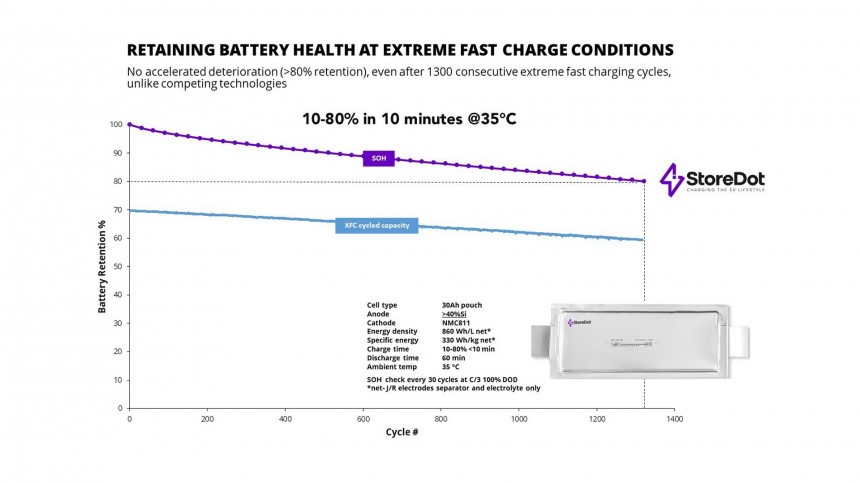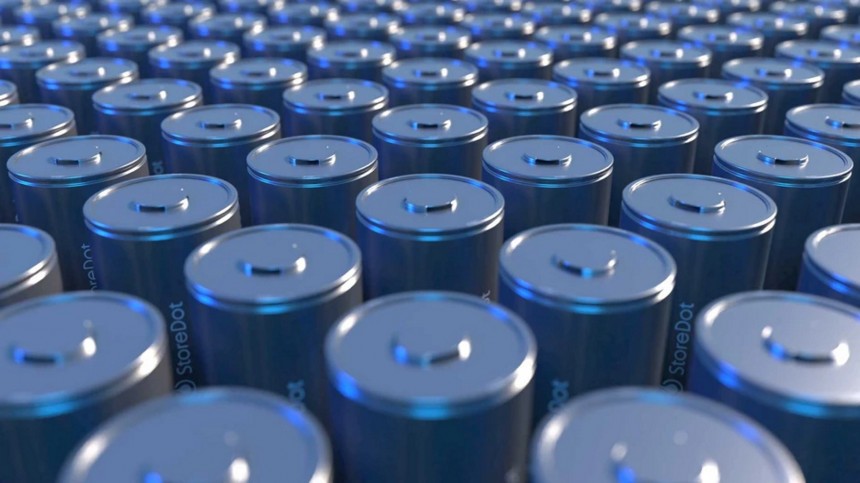Recurrent recently disclosed that fast charging shows "no statistically significant difference in range degradation." Several people took that as a free pass for frequently submitting battery packs to that charging process, which led StoreDot to manifest about that. Without mentioning the BEV analytics company, the Israeli battery startup warned that this is a dangerous assumption that can lead to problems in the long term unless these battery packs have something similar to the technology it wants to sell. StoreDot also disclosed more info about its future Extreme Fast Charging (XFC) cells.
According to the Israeli startup, its 30-Ah pouch batteries deliver a net volumetric energy density of 860 Wh/l and a net gravimetric energy density of 330 Wh/kg, which is much higher than the 260 Wh/kg that some of the best NMC cells currently available offer. XFC batteries share the same chemistry (NMC811) in their cathodes, which Our Next Energy (ONE) said we should be worried about. The American battery startup believes mixing nickel and cobalt represents "a major thermal runaway risk." In other words, it considers NMC batteries can catch fire, which is why it bets on lithium iron phosphate (LFP). StoreDot does not seem to be concerned with that. Its manufacturing edge is the anode, which contains more than 40% of its "unique silicon-dominant chemistry."
NIO uses WeLion semi-solid-state battery packs that deliver 360 Wh/kg, but they are still in limited distribution, available only for the company's 150-kWh swappable battery pack. StoreDot promises its cells will charge from 10% to 80% capacity in less than ten minutes. That's a third of what most battery electric vehicles (BEVs) currently for sale can offer: they demand at least half an hour for the same task.
When XFC cells hit the market in 2024, their competitive advantages compared to the ones sold nowadays will go beyond saving time: they are also supposed to last much longer. According to StoreDot, these batteries retain 80% of their capacities after 1,300 consecutive extreme fast charging cycles. If you imagine a battery pack that offers 300 miles (482.8 kilometers) of range, 1,300 cycles would mean 390,000 miles (627,644 km) if the capacity didn't drop – but it does. If that happened at a constant pace until it reached 240 miles (80% of the original capacity), that would reduce this lifespan to 351,160 miles (535,167 km).
Bear in mind that most BEV makers will only replace their battery packs under warranty if they drop below 70% of their capacities. That means such a battery pack with XFC cells would last way more than 1,300 cycles and 350,000 miles – which is pretty reasonable for any vehicle, especially BEVs. In a quick calculation – also using a hypothetical capacity decrease rate – such a BEV would need more than 1,950 cycles to drop below 210 miles of range. This vehicle would then have run 499,058 miles (803,156 km). Unfortunately, capacity drops are not linear, but this exercise can give us a fair idea of what to expect.
On March 31, I wrote a story warning about another Recurrent study that people took at face value to demonstrate battery packs last for a long time. The BEV analytics company itself admitted it had several flaws. The truth is we still do not have enough old electric cars around to confirm their battery packs will outlast the vehicles they power. The stories we have right now even contradict that. Several Nissan Leaf and Tesla Model S are dying because their battery packs are failing, and it does not make sense to replace them from a financial perspective: the battery packs cost more than the cars.
This time, the Recurrent study analyzed over 12,500 Teslas that were charged often or just every once in a while. This group was divided into 6,300 Model 3 units and 4,400 Model Ys, which total 10,700 vehicles. The other 1,800 BEVs can only be Model S, Model X, and Roadsters. Most of them must be Model S units, but Recurrent did not release these numbers or make a graphic with them – probably because they were not statistically relevant. Yet, they are the group's most relevant members: the only ones that may have expired warranties.
Recurrent did not reveal if the analyzed vehicles had their battery packs replaced under warranty. Supposing all of them still have the same component with which they left the factory, they are still too new to present a trustworthy example of the impact fast charging can have on battery packs in the long run. Some Model 3s are only 2,000 days (5.5 years) old, and the analytics company did not disclose how many fit into that description. The Model Y units are 1,000 days (2.7 years) old. All of them are still under warranty. If fast charging damaged these battery packs, Tesla would have had to replace them for free. In other words, Recurrent's study needs to answer several questions before it becomes a credible reference for anyone. That did not stop StoreDot from addressing it.
The Israeli startup did not mention anyone directly, but it also did not have to. On the other hand, if Recurrent's study could be taken seriously, the only reason for anyone to consider XFC cells would be the charging speed, not the durability StoreDot promises they will have. It makes sense that the startup reinforces that its tech makes cells last longer even under constant fast-charging sessions and that regular cells don't. Even Recurrent makes charging recommendations at the end of its study, such as preconditioning the battery pack. It also states that "it's still difficult to quantify precisely how much routine fast charging affects battery health long term – 5, 10, 20 years – but it's fine in small doses." That alone contradicts the study's conclusions (or at least puts them into the proper perspective).
The first vehicles to use XFC cells should come from VinFast, Polestar, or Volvo, the automakers that officially support StoreDot. If the technical specifications the Israeli company disclosed are confirmed for production cells, they will be anxious to sell anything powered by them.
NIO uses WeLion semi-solid-state battery packs that deliver 360 Wh/kg, but they are still in limited distribution, available only for the company's 150-kWh swappable battery pack. StoreDot promises its cells will charge from 10% to 80% capacity in less than ten minutes. That's a third of what most battery electric vehicles (BEVs) currently for sale can offer: they demand at least half an hour for the same task.
When XFC cells hit the market in 2024, their competitive advantages compared to the ones sold nowadays will go beyond saving time: they are also supposed to last much longer. According to StoreDot, these batteries retain 80% of their capacities after 1,300 consecutive extreme fast charging cycles. If you imagine a battery pack that offers 300 miles (482.8 kilometers) of range, 1,300 cycles would mean 390,000 miles (627,644 km) if the capacity didn't drop – but it does. If that happened at a constant pace until it reached 240 miles (80% of the original capacity), that would reduce this lifespan to 351,160 miles (535,167 km).
On March 31, I wrote a story warning about another Recurrent study that people took at face value to demonstrate battery packs last for a long time. The BEV analytics company itself admitted it had several flaws. The truth is we still do not have enough old electric cars around to confirm their battery packs will outlast the vehicles they power. The stories we have right now even contradict that. Several Nissan Leaf and Tesla Model S are dying because their battery packs are failing, and it does not make sense to replace them from a financial perspective: the battery packs cost more than the cars.
This time, the Recurrent study analyzed over 12,500 Teslas that were charged often or just every once in a while. This group was divided into 6,300 Model 3 units and 4,400 Model Ys, which total 10,700 vehicles. The other 1,800 BEVs can only be Model S, Model X, and Roadsters. Most of them must be Model S units, but Recurrent did not release these numbers or make a graphic with them – probably because they were not statistically relevant. Yet, they are the group's most relevant members: the only ones that may have expired warranties.
The Israeli startup did not mention anyone directly, but it also did not have to. On the other hand, if Recurrent's study could be taken seriously, the only reason for anyone to consider XFC cells would be the charging speed, not the durability StoreDot promises they will have. It makes sense that the startup reinforces that its tech makes cells last longer even under constant fast-charging sessions and that regular cells don't. Even Recurrent makes charging recommendations at the end of its study, such as preconditioning the battery pack. It also states that "it's still difficult to quantify precisely how much routine fast charging affects battery health long term – 5, 10, 20 years – but it's fine in small doses." That alone contradicts the study's conclusions (or at least puts them into the proper perspective).
The first vehicles to use XFC cells should come from VinFast, Polestar, or Volvo, the automakers that officially support StoreDot. If the technical specifications the Israeli company disclosed are confirmed for production cells, they will be anxious to sell anything powered by them.






















